Spotify launched back in 2008 with a simple mission: “To unlock the potential of human creativity—by giving a million creative artists the opportunity to live off their art and billions of fans the opportunity to enjoy and be inspired by it.”
Spotify now has 144 million subscribers, 320 million active users, 60 million tracks, and 4 billion playlists.
The company’s success was partly due to the fact that they were one of the first to revolutionize the music industry in this way — giving artists a platform to make money and listeners access to millions of tracks for free or for a small monthly fee (depending on if users want ads).
But what we’re most interested in here (as with all of our Teardowns) is how Spotify has used email marketing to generate leads, convert leads into customers, and reduce churn.
Let’s start with lead generation.
Spotify Lead Generation
For the most part, Spotify has a product-centric lead-gen strategy, just as Grammarly and Headspace (two other companies we’ve done teardowns on).
This means that the primary way that Spotify generates leads is by offering a free version of their service.
You can see that, on their website, signing up is really the only way to get on their email list.
Their primary offer is 3 months of Premium Spotify for free. This is good for business because many of those people will stay on and pay a monthly fee for their subscription after 3 months.

But right below that CTA is another one for people who just want to download the free version of Spotify. Here’s what it looks like…
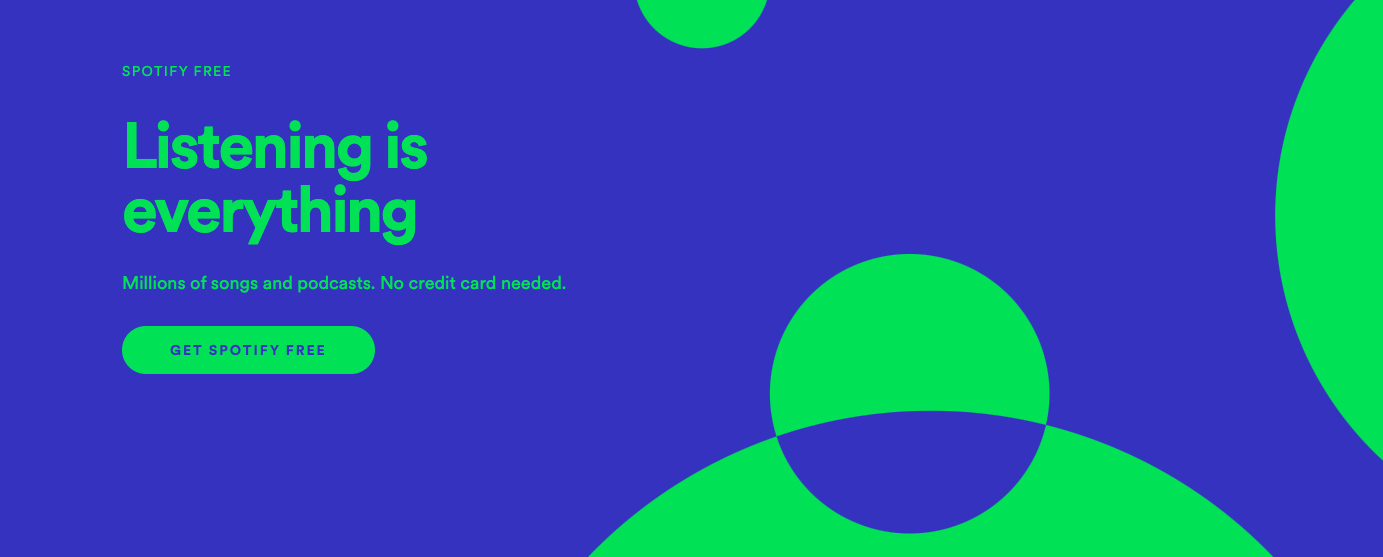
Clicking on the first “3 Months Free” CTA takes users to a page where they can login or create their account…
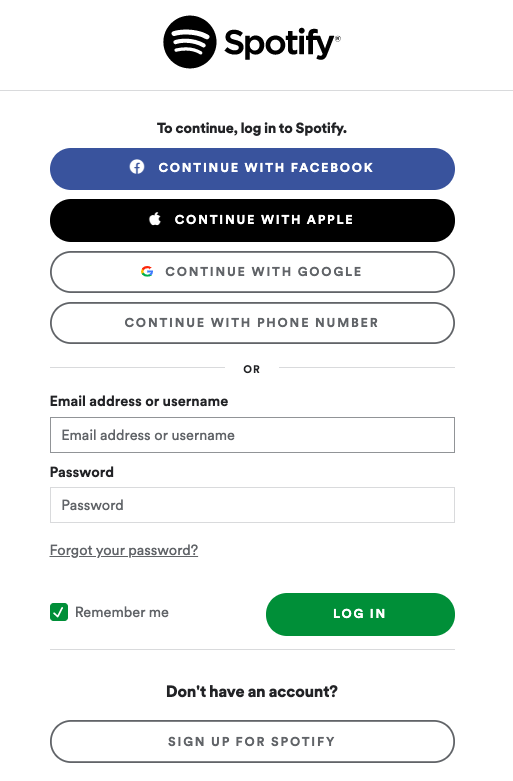
Clicking on the 2nd CTA starts an automatic download for the Spotify app on your device…
The great thing about having an app-based business like Spotify is that the service is naturally easy to use on lots of different devices.
It’s also easy for users to create a habit of using the service since it just takes a single click on their mobile device.
Clearly, Spotify’s primary lead-gen strategy is to get new people downloading and using their app, even if it’s the free version.
(After all, Spotify still makes money from advertisers if users don’t pay for Premium)
But that’s not quite the whole story.
Spotify also has their For The Record site, where they publish podcasts and blog posts. Here, there’s a simple newsletter opt-in CTA…
Still, from what we can tell, most of Spotify’s efforts, including their Facebook ads, simply encourage people to download the app.
Click on the “Listen Now” button for this Facebook ad, for example, and you’re taken straight to Spotify’s IOS app.
So when it comes to generating leads, it’s all about getting people to start using the free version of Spotify’s service in hopes that they’ll come back and pay for the Premium version.
And as we’ll see in the upcoming emails, Spotify really seems to only have two goals with their email marketing…
- Keep people using the service.
- Upgrade as many people to Premium as possible.
Spotify Welcome Email & Upsell Emails
Spotify’s welcome email is also their “Confirm Your Account” email.
Here’s what it looks like, with the simple subject line, “Confirm your account”.
| Subject | Confirm your account | |
| Sent | Immediately after signup | |
| CTA |  |
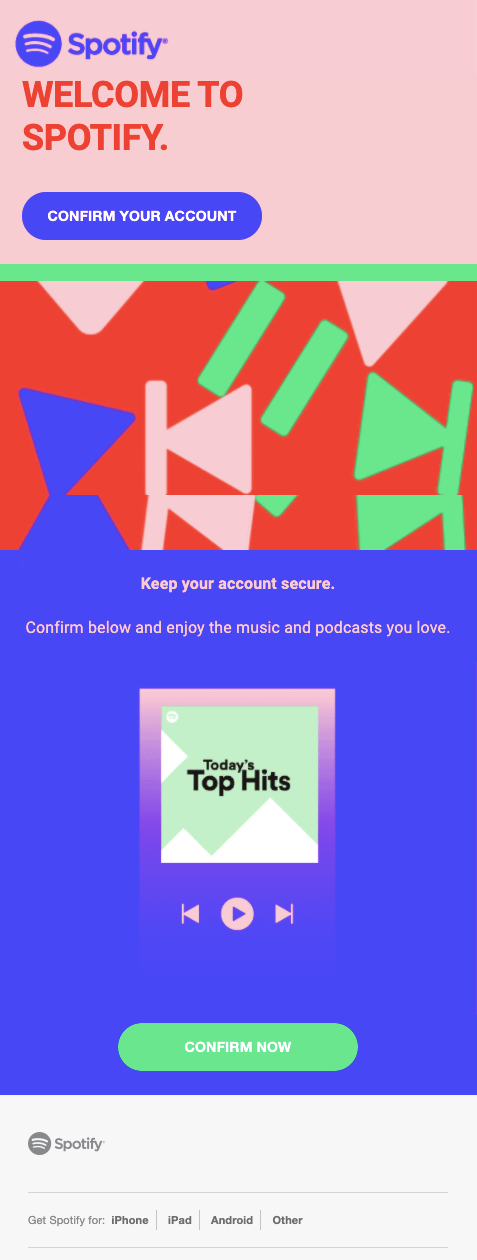
This email isn’t very thrilling, but it is succinct and to the point, which is good for a “Confirm Your Account” email (give people too much to do and they might forget to double opt-in).
There’s a CTA at the top and the bottom, but the bottom CTA gives a little push by saying, “Confirm below and enjoy the music and podcasts you love.”
(In fact, upon first glance and without reading the button copy, we thought that the bottom CTA was to start using Spotify immediately)
After we received this simple email, our inbox went quiet for about two and a half weeks.
Then we got a Spotify email with the subject line, “Premium for the win: try 3 months free”.
| Subject | Premium for the win: try 3 months free | |
| Sent | 18 days after signup | |
| CTA |  |
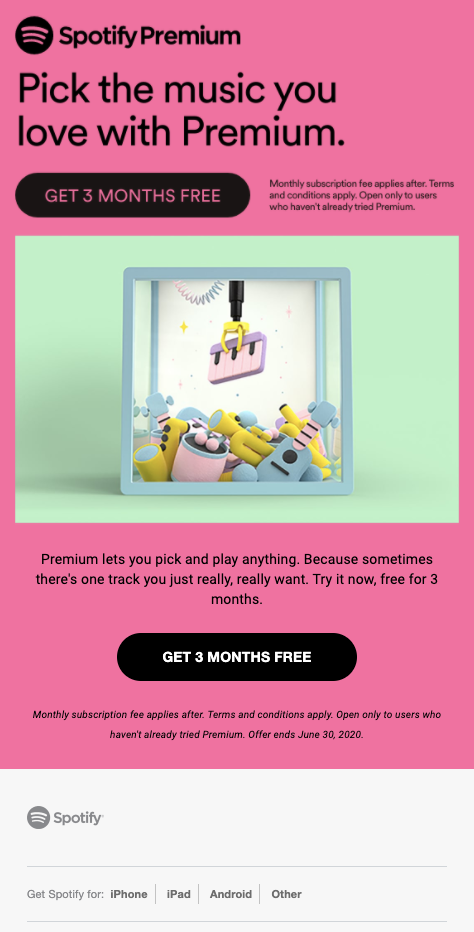
From what we can tell, this email seems to be the beginning of their sequence to upsell new freemium members.
This email offers three months free of Spotify Premium, which is the offer that they’ll be promoting over the next few emails. The copy is pretty simple, with only a single explanation:
“Premium lets you pick and play anything. Because sometimes there’s one track you just really, really want. Try it now, free for 3 months.”
In this case, so long as that copy is enough to create interest and draw clicks, this simplicity is fine because the landing page does a thorough job of explaining the benefits of Spotify’s Premium plan.
You’ll also notice that in small text at the bottom of the email, there’s mention of this offer ending on June 30th, which creates just a touch of urgency (if people even read that part — we almost missed it).
Now let’s address the elephant in the room.
Why the two-and-a-half-week wait between the “Confirm your account” email and this email?
Well, we can only guess. But it’s probably because Spotify wants to give new users a few weeks to experience the free version of their service (and *cough* the annoying ads *cough*) before pitching their Premium plan.
That’s not such a bad idea — that wait time can certainly help avoid annoying new subscribers with immediate upsells.
But not to send anything?
If we’re being honest, we think it’d be best for Spotify to send at least a few habit-building emails during those weeks — emails that teach people how to make the most of their Spotify experience and encourage them to keep coming back for more (Headspace and Grammarly both do this, for instance).
It seems like a lost opportunity.
But we digress.
We received another email from Spotify 6 days later, with the subject line, “Free for 3 months: dig in with Premium.”
| Subject | Free for 3 months: dig in with Premium | |
| Sent | 6 days after the previous one | |
| CTA |  |
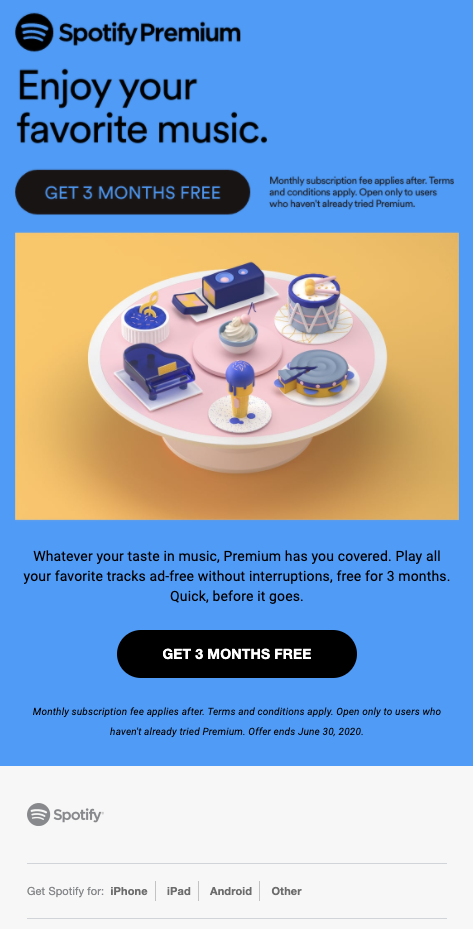
This email is also pretty basic.
One thing worth noting, though, is that this is Spotify’s first mention (in an email) of the fact that Premium allows users to listen “ad-free without interruptions” — that seems like a compelling reason for people to upgrade.
It’s also the first time that they mention in no uncertain terms that the offer is going away (“Quick, before it goes”).
For those reasons, this email feels more persuasive than the former.
Five days later, we received another email with the subject line, “Skip to Premium: 3 months free”.
| Subject | Skip to Premium: 3 months free | |
| Sent | 5 days after the previous one | |
| CTA |  |
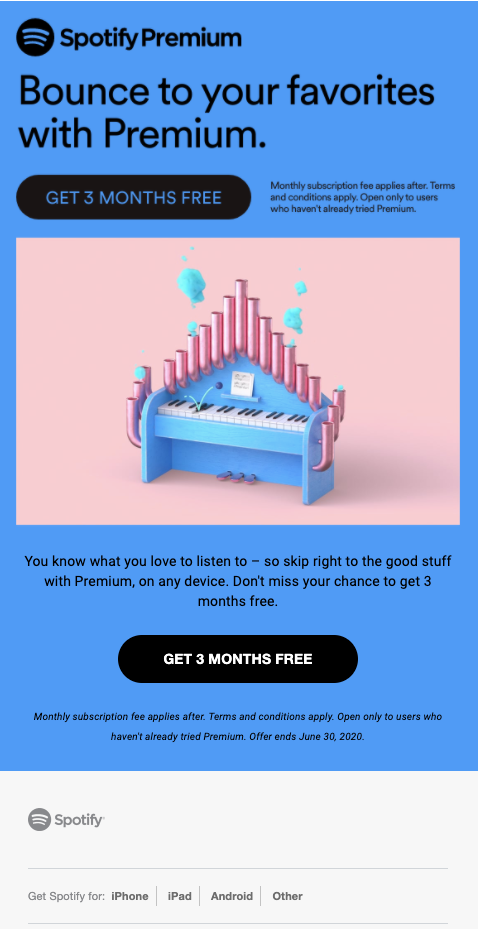
This email is very similar to the previous emails. The only real difference is the Premium feature focus, which is about listening “on any device.”
Three days later (and four days before June 30th, when the offer was supposed to end), we received this email, with the subject line, “Last chance. Try Premium free for 3 months.”
| Subject | Last chance. Try Premium free for 3 months. | |
| Sent | 3 days after the previous one | |
| CTA |  |
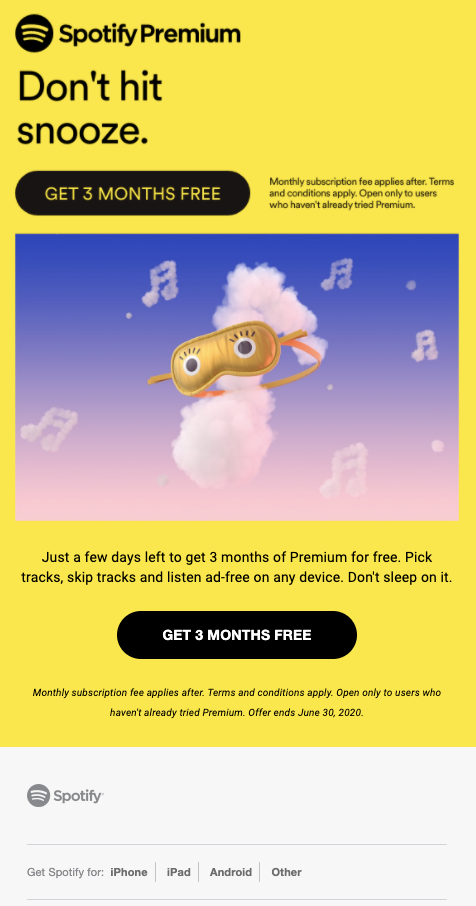
Unlike the previous emails, this one mentions all of three main Premium features — “Pick tracks, skip tracks and listen ad-free on any device.”
But like its predecessors, it’s short and sweet.
That brings up a good point.
One thing you’ll notice about these emails is how consistent they all feel with Spotify’s brand — they all have Spotify-appropriate colors, graphics, fonts, and images.
And there’s a lot to be said for creating a consistent brand experience (consistent presentation of a brand can increase revenue by up to 33%, according to Oberlo).
The final email we received in this upsell sequence had the subject line, “Final days. 3 months of Premium free.” Here’s what it looked like…
| Subject | Final days. 3 months of Premium free | |
| Sent | 3 days after the previous one | |
| CTA |  |
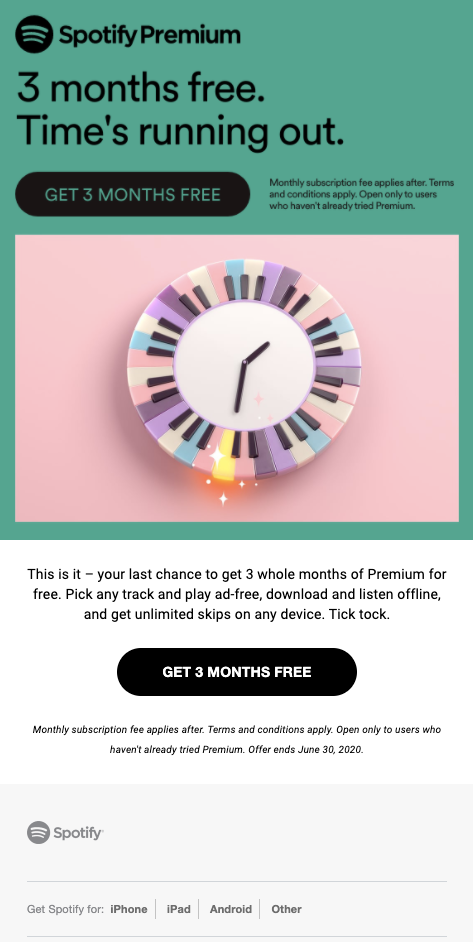
Again, this email is quite simple. We received it when there were two days until June 30th, the end of the offer.
(Interestingly, we didn’t receive any email on June 30th)
Additionally, as of this Teardown’s writing, Spotify has this exact same three-months-free offer on their homepage, with the end-date of December 31st.
From looking at screenshots of Spotify’s website on WayBackMachine, it seems like this offer is a biannual one — they offer it in June and also during the holiday season.
So we just happened to subscribe during a time when this was their primary promotion, but they likely have an entirely different upsell sequence during other times of the year.
Once this promotion finished, we received only two more emails — one in July and one in August (that’s pretty sparse contact, if you ask us).
Here’s the email from July, with the subject line “Premium Duo, two accounts together. One month free.”
| Subject | Premium Duo, two accounts together. One month free. | |
| Sent | 8 days after the previous email | |
| CTA |   |
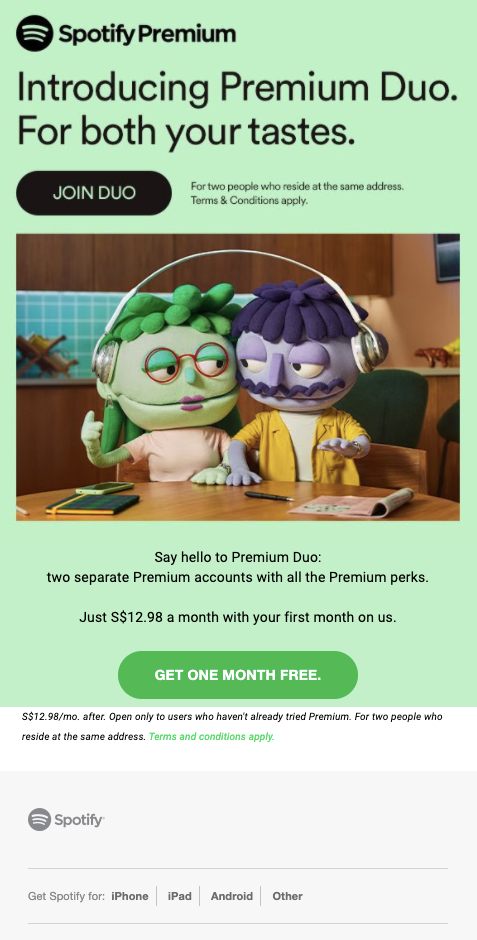
And here’s the email from August, with the subject line, “A world of Premium, free for 1 month.”
| Subject | A world of Premium, free for 1 month | |
| Sent | 3 days after the previous email | |
| CTA |  |
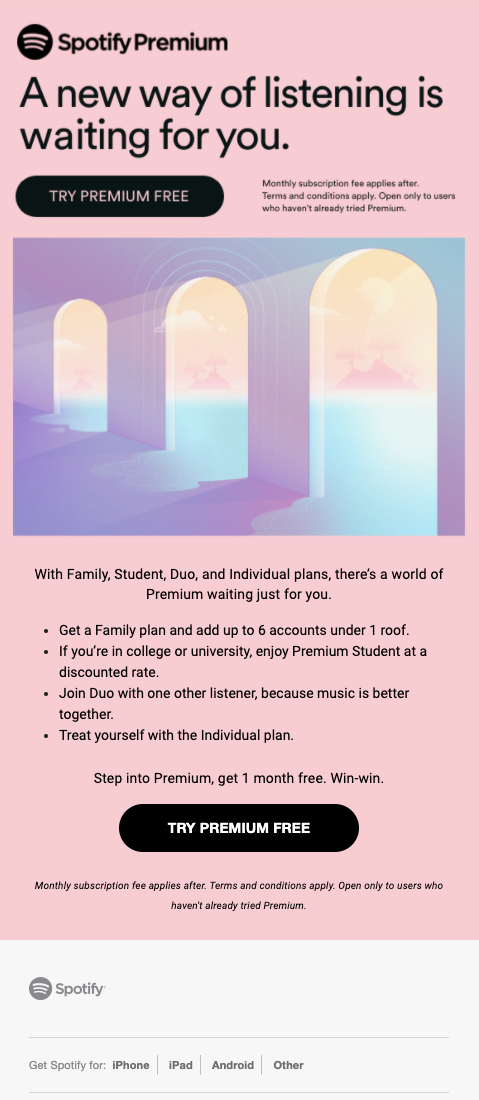
How does this compare to your own upsell email strategy?
Having a biannual promotion isn’t such a bad idea. It’s a good way to change things up from your normal upsell sequence and, if it only happens a couple of times a year, then it will continue to feel fresh to new subscribers.
However, we don’t recommend waiting two weeks to email your new freemium members — that’s a great time to help them get in the habit of using your service (and all SaaS businesses depend on consistent usership).
Spotify Post-Purchase Emails
After receiving those upsell emails, we finally bit the bullet and signed up for Spotify Premium.
Here’s what Spotify’s first post-purchase email looked like, with the subject line, “Premium starts now 🙌”.
| Subject | Premium starts now | |
| Sent | Immediately after signup | |
| CTA |  |
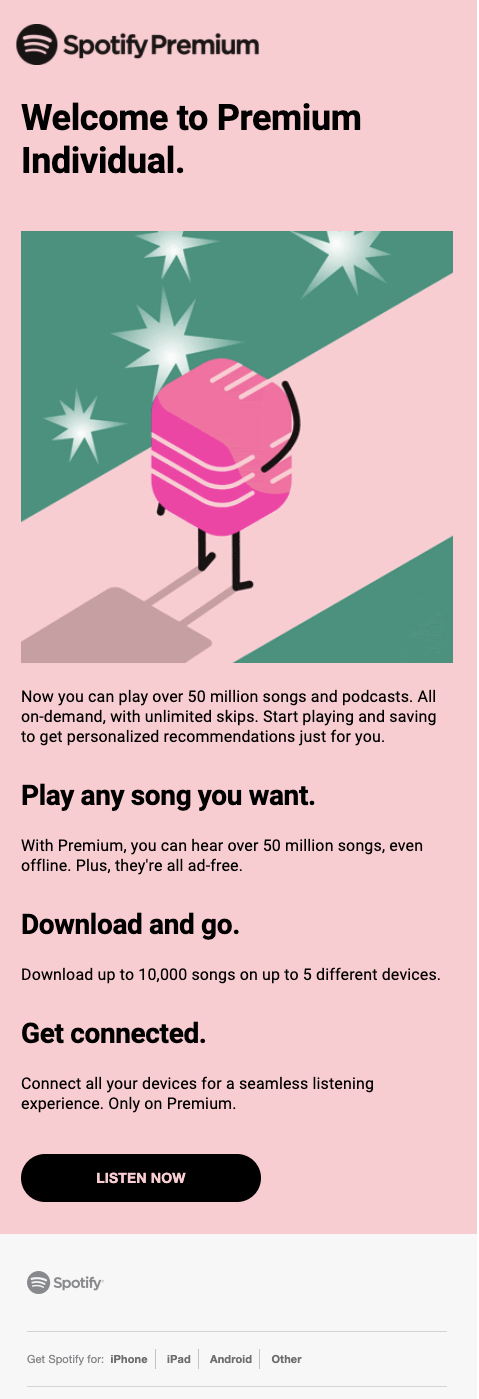
Fittingly, as we just signed up for Premium, this email has a single goal — to get us using our new premium account.
They succinctly stuff all of the benefits of Premium into this email and then add a “Listen Now” CTA.
This is an important email because the sooner that someone starts using their new account — and the more often they return — the less likely they are to cancel.
SaaS companies should take note.
In fact, the next email we received encouraged us to create our own playlists (which improves product habituation). It had the subject line, “Are your favorite artists in Your Library yet?”
| Subject | Are your favorite artists in Your Library yet? | |
| Sent | 3 days after signup | |
| CTA |   |

And the next email encouraged us to connect our devices to Spotify (ease-of-use usually means less churn).
It had the subject line, “Connect 📺 your 🚗 devices 🔈”.
| Subject | Connect 📺 your 🚗 devices 🔈 | |
| Sent | 2 days after previous email | |
| CTA |  |

And finally, over the next few weeks, we received emails that encouraged us to use pre-made playlists and to make use of different Premium features (such as Spotify Radio).
Here’s one example, with the subject line, “Playlists made just for you.”
| Subject | Playlists made just for you. | |
| Sent | 3 days after previous email | |
| CTA |  |

And here’s another example, with the subject line, “Listen to ad-free radio”.
| Subject | Listen to ad-free radio | |
| Sent | 1 week after the previous email | |
| CTA |  |
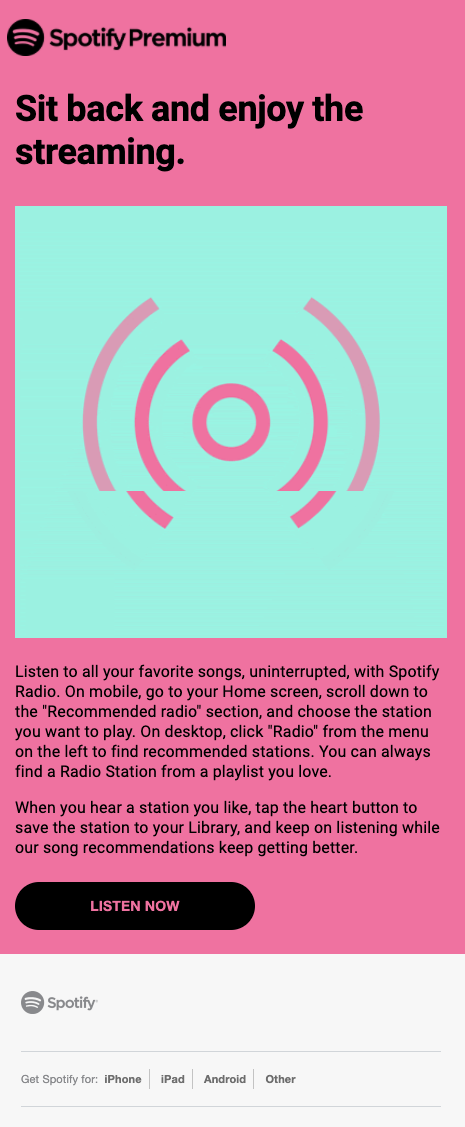
So let’s recap.
- The first email encourages immediate use and introduces some cool Premium features.
- The second email encourages the user to create their own playlists (which improves habituation to the product)
- The third email encourages users to connect Spotify to all their devices.
- And the remaining emails encourage members to make the most of Premium-specific features as well as create a habit out of using Spotify.
Pretty simple, huh?
But effective for SaaS companies.
How do your own post-purchase emails compare?
Spotify Cancellation & Re-Enrollment Emails
What does Spotify do if someone cancels their Premium account?
That’s what we wanted to find out. So we canceled our subscription and monitored our inbox. Here’s the first email we received, with the subject line, “You’ve canceled your Spotify subscription”.
| Subject | You’ve canceled your Spotify subscription | |
| Sent | Immediately after cancellation | |
| CTA |  |
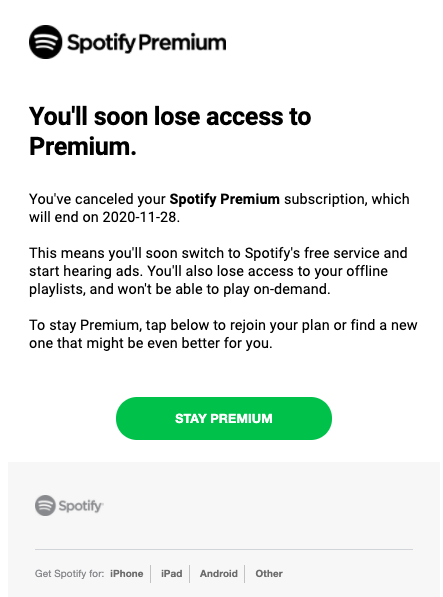
We appreciate the straight-forwardness of this email.
While it definitely makes an effort to recapture the lost customer, it does so without being too sales-y or desperate.
It just says it like it is…
- “You’ve canceled…”
- “This means you’ll… start hearing ads.”
- “You’ll also lose access to your offline playlists, and won’t be able to play on-demand.”
Some people cancel quickly without really thinking of the repercussions. This email reminds them of what will happen now that they’ve cancelled.
On one hand, it’s helpful. On the other, it’s a reminder of the benefits of Spotify Premium.
Fittingly, the CTA is to “stay Premium” or find a new plan that “might be even better for you.”
We received the next re-enrollment email 3 days later, with the subject line, “Reasons to stay Premium”.
| Subject | Reasons to stay Premium | |
| Sent | 3 days after cancellation | |
| CTA |  |
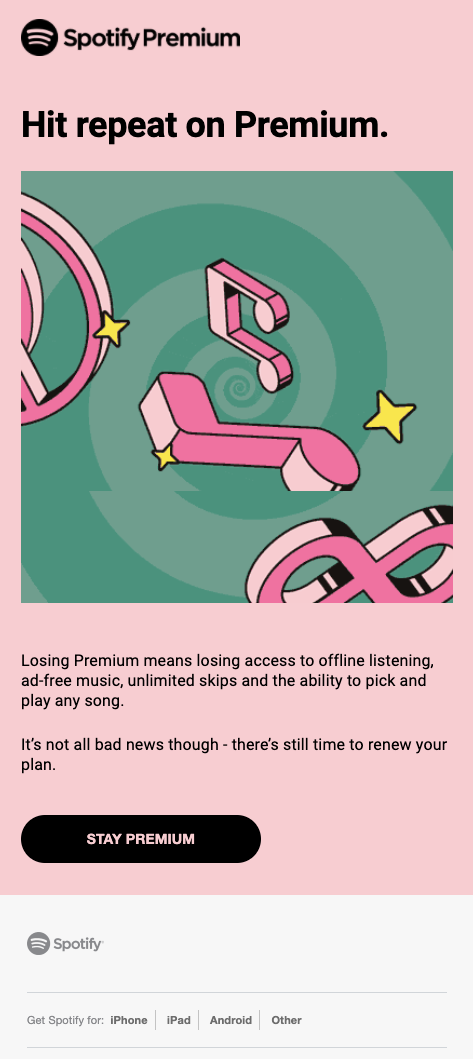
This email is very similar to the first.
It reminds the canceller of the benefits of staying Premium (or rather, the disadvantages of not staying Premium) and tells them that there’s still time to re-enroll.
That’s all good to go.
But there’s one thing we noticed with this email that we wouldn’t advise.
This email was sent from “no-reply@spotify.com”
That means that receivers of this email can’t hit reply to respond. They can’t ask questions about re-signing up, they can’t express concerns, and they can’t provide Spotify with information on why they cancelled in the first place… all because the email was sent with a “no-reply” address.
We think that’s a waste.
Instead, why not send this email from a customer support address so that people can respond, ask questions, and provide valuable information about their experience?
It would certainly mean more emails to respond to… but it’d also be a great opportunity for Spotify to learn about customers and why they cancel.
(Which is extremely valuable information for any SaaS)
Nonetheless, we received one more email 3 days later and 4 days before our cancellation went into effect, with the subject line, “You’re now on Spotify Free”.
| Subject | You’re now on Spotify Free | |
| Sent | 6 days after the cancellation | |
| CTA |   |

The subject line indicates that we’re now on Spotify Free, which is a little misleading — we actually had 4 more days until our cancellation took effect.
Still, this email does a good job of addressing a main concern that many cancellers likely have: price.
Instead of discussing the benefits of Premium (like the previous cancellation emails), this email gives people “a couple of ideas that could help [them] stay Premium”.
More specifically, they recommend more affordable plans and different payment methods.
Considering that the person already understands the benefits of Premium by this point in their journey, that’s not such a bad idea — price is a big deal to people, so why not address it directly?
Side-Note: These are the U.S.-based emails that we received after cancellation. We also subscribed to Spotify in Malaysia (thanks to our awesome VA) and received different re-enrollment emails that actually offered a discount. This indicates that Spotify is using different email marketing campaigns in different countries (ideally, based on each individual culture). That’s an important practice for large international companies.
Download The Visualized Teardown
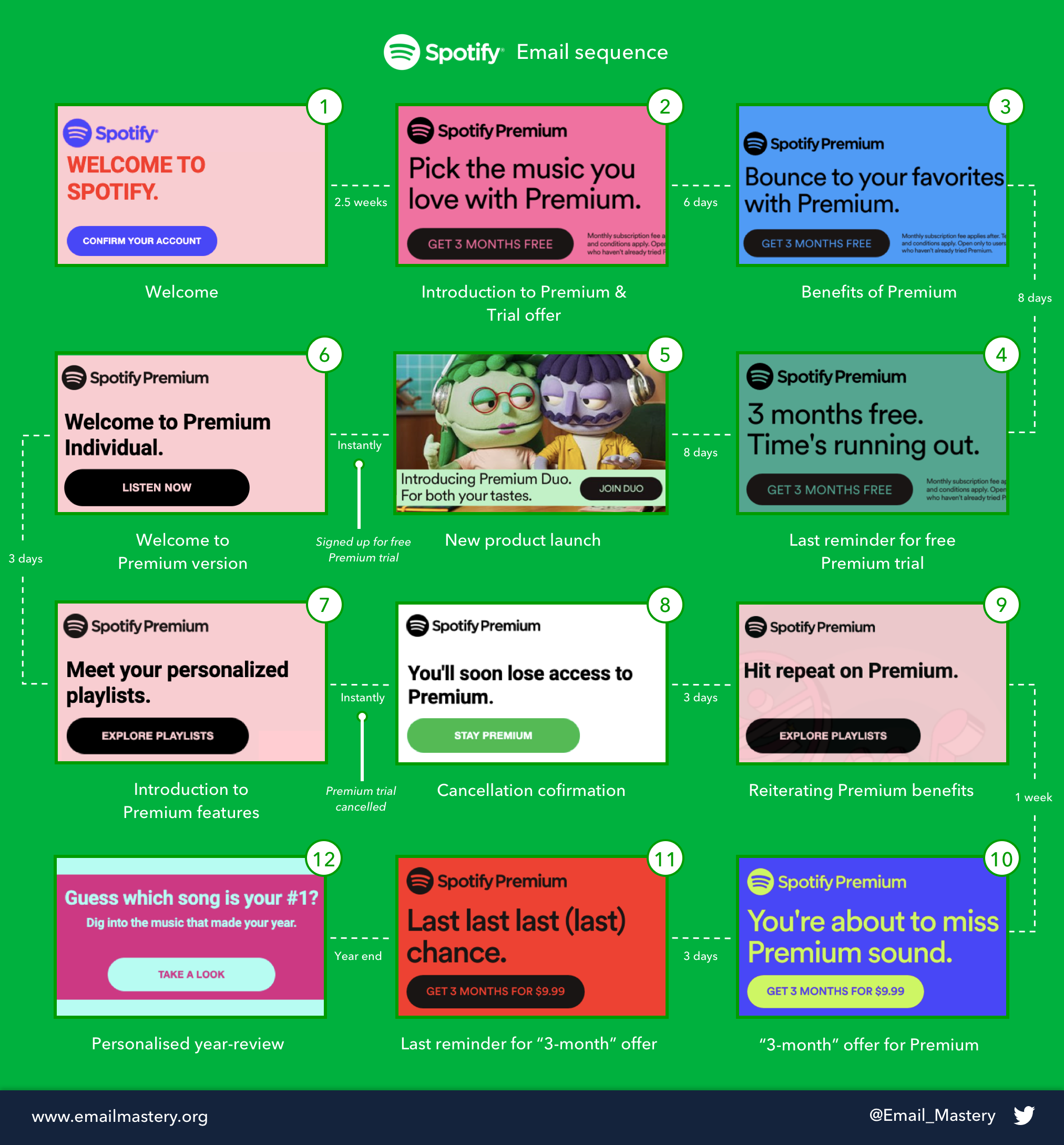
Download the Visualised Teardown
Enter your email address to download our one-page visualisation.
We respect your privacy. Unsubscribe at any time.
Conclusion
Spotify is a decade-old company that’s found huge success.
They disrupted the music industry, creating a simple way for people around the world to access 50,000 million different tracks for as little as $10 per month.
But things we’re always that way.
Like any successful SaaS company, Spotify had to work for their explosive growth.
And when it comes to their email marketing strategy, you now know what they’re doing.
Compare Spotify’s campaigns to your own, learn from the differences, and iterate — that’s the process of long-term success.
